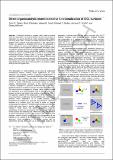Direct organocatalytic enantioselective functionalization of SiOx surfaces
View/
Date
20/07/2018Author
Grant ID
EP/J018139/1
RPG-2015-109
ep/k000411/1
ep/l017008/1
EP/J018139/1
N/A
Keywords
Metadata
Show full item recordAbstract
Traditional methods to prepare chiral surfaces involve either the adsorption of a chiral molecule onto an achiral surface, or adsorption of a species that forms a chiral template creating lattices with long range order. To date only limited alternative strategies to prepare chiral surfaces have been studied. In this manuscript a “bottom-up” approach is developed that allows the preparation of chiral surfaces by direct enantioselective organocatalytic reactions on a functionalized silicon oxide supported self-assembled monolayer (SAM). The efficient catalytic generation of enantiomerically enriched organic surfaces is achieved using a commercially available homogeneous isothiourea catalyst that promotes an enantioselective Michael-lactonization process upon a silicon-oxide supported SAM functionalized with a reactive trifluoroenone group. Chiral atomic force microscopy (χ-AFM) is used to probe the enantiomeric enrichment of the organic films by measurement of the force distributions arising from interaction of d- or l-cysteine-modified AFM tips and the organic films.
Citation
Parkin , J D , Chisholm , R , Frost , A B , Bailey , R G , Smith , A D & Hähner , G 2018 , ' Direct organocatalytic enantioselective functionalization of SiO x surfaces ' , Angewandte Chemie International Edition , vol. 57 , no. 30 , pp. 9377-9381 . https://doi.org/10.1002/anie.201804814
Publication
Angewandte Chemie International Edition
Status
Peer reviewed
ISSN
1433-7851Type
Journal article
Description
We thank the Engineering and Physical Sciences Research Council (GH, ADS and JDP acknowledge EP/K000411/1 and EP/L017008/1, and ADS and ABF acknowledge EP/J018139/1) and the Leverhulme Trust (GH and RGB acknowledge RPG2015-109). This work was supported by the European Research Council under the European Union’s Seventh Framework Programme (FP7/2007–2013) ERC grant agreement no. 279850. ADS thanks the Royal Society for a Wolfson Research Merit Award.Collections
Items in the St Andrews Research Repository are protected by copyright, with all rights reserved, unless otherwise indicated.

